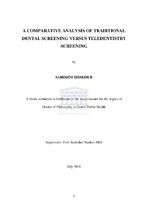| dc.description.abstract | Background: Teledentistry is the use of information and communications technology (ICT) to provide oral health care services and enhance oral health care delivery to communities in geographically challenged areas. The public health services in South Africa needs to be overhauled to address the inadequacies in the current system. As an attempt to minimise or repair the inadequacies in the public health sector, South Africa has identified the use of ICT’s as a potential tool in improving the delivery of health care. However, although SA has recognised telemedicine as a potential solution to improve access to health care, teledentistry does not feature at all in the dental public health sector. Teledentistry and mobile health has the potential to eliminate or minimise the oral health disparities that exist in South Africa with the use of health information systems. Teledentistry can be initiated in an incremental approach by 'piggy-backing' on existing telemedicine sites, thus reducing ICT costs for the public health sector. Stake holders and government officials need to embrace technology to address some of the challenges that exist in the South African public health sector. This study could aid in providing evidence-based information to assist in the introduction of teledentistry in South Africa as an innovative dental screening and management tool. The most recent SA National Oral Health Survey showed that at least 80% of dental caries in children is untreated (Department of Health, 2003) and this poses a significant public health problem. To reduce the double burden of dental caries in children and human resource shortages in the public sector, the use of teledentistry as a school screening tool has been recommended. Teledentistry screening has the potential to improve access and delivery of oral health care to children in underserved and the rural areas. The aim of the study is to compare traditional dental screening versus teledentistry screening for dental caries in children. Methodology: This study consists of two parts: the first part a concordance study and the second part the determination of user satisfaction with regards to the technology used. The concordance study assessed the diagnostic agreement between traditional and teledentistry screening of dental caries in school children aged between 6-8 years old. The methodology included traditional face-to-face dental screening by two trained and calibrated evaluators, and the teledentistry screening method included the same two evaluators together with two trained and calibrated teledentistry assistants (who were of non-dental background). For the traditional face-to-face dental screenings the two evaluators examined 233 children at selected rural primary schools and scored them for DMFT. For the teledentistry screening method the teledentistry assistants captured intraoral images of the same children and web-based stored the images in corresponding eFiles. After a two week wash out period these intraoral images were then examined by the same two evaluators and scored for DMFT. To determine concordance across methods, Kappa Statistics was applied to the data and this revealed intra-examiner reliability. To determine user satisfaction levels, close-ended questionnaires were designed based on the role of the evaluators and TAs in the teledentistry screening process. Results: The intra-rater agreement and reliability across methods for evaluator one was 98.30%, and for evaluator two it revealed a result of 95.09%. Kappa statistics thus revealed that both evaluators were in agreement between a range of 95%-98.30% of the classifications, or 92.79% of the way between random agreement and perfect agreement (p=0.000). The high concordance level indicated that there was no statistical difference between the traditional dental screening method and the teledentistry screening method (intra-rater reliability), thus suggesting that the teledentistry screening method is a reliable alternative to the traditional dental screening method. For the user satisfaction part, both of the evaluators agreed with 8 of the 13 statements (62%). The statements that were agreed upon related mainly to user satisfaction on the technology which included accessing the intraoral images for screening and the ease of scoring decayed and missing teeth off the images; time and technology suggested the screening process of the images saved time; and indicated teledentistry as being an innovative and easy system to use that will save clinical time for dental professionals. The statements they disagreed with related to the clarity of the images, scoring interproximal caries off the images, and the dental screening method of choice. Both of the TAs agreed with 7 of the 11 statements (64%). They agreed upon statements related mainly to perception of children’s attitudes & behaviour which suggested the children were comfortable during the imaging process and in addition they were excited to see pictures of their teeth; they found teledentistry to be an innovative and easy system to use; they found teledentistry to be a sterile process and hence they were happy with infection control. Both TAs disagreed with the statement that suggested clear images could be captured irrespective of poor lighting. Discordant statements related mainly to user satisfaction on technology which related to ease of using the intraoral camera, ease of storing the captured images into the eFiles and ease of deleting unwanted images. Conclusion: The key findings of this study highlights the reliability of utilising teledentistry as a dental screening and diagnostic tool which can be valuable in the delivery of oral health care in South Africa. This research study further revealed valuable data on user satisfaction levels of the evaluators and TAs, and has an impact on the utilisation of the teledentistry screening system. To ensure adoption and adaptation of the screening process all users must be satisfied with the ICTs used in the teledentistry system. User friendliness can impact negatively on the adoption of teledentistry. | en_US |

